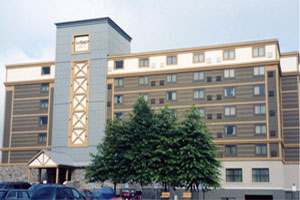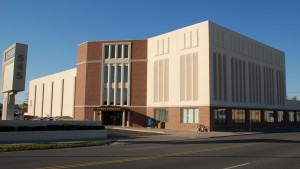Historical Stucco
The use of stucco can be dated back to ancient times and is still used throughout the world today as one of the most common traditional building materials. Stucco is a form of exterior plaster applied directly onto masonry, wood or metal lath or wood frame structures. Stucco is a kind of chameleon in the building world as it can often be used to disguise or mimic the look of other materials without going noticed. Many people confuse traditional stucco with more modern synthetic finishes such as EIFS.
Stucco’s popularity has grown as it is a relatively inexpensive material compared to other exterior finishes, which can be used to imitate different designs. This material can give the appearance of a more expensive, high-end exterior finish. Stucco is also a great material to protect your structure from the elements when installed correctly, and can give a certain amount of fire-protection as well.
Historic stucco primarily was composed of hydrated or slaked lime, water and sand mixed with a binder such as straw or animal hair. Natural cements were also used in mixes during the 1820s. After Portland cement was first manufactured in the 1870s, most stucco was composed of portland cement and lime, making the materials more durable and versatile. Waxes and oils were added to introduce water-repellent properties. Modern materials commonly used today consist of synthetic stucco systems such as Exterior Insulation Finish Systems (EIFS) which provide the features of stucco with additional benefits such as insulation and energy savings.
Regardless of the exterior material on a structure, regular maintenance is important to the overall longevity and integrity of the building’s facade. Unfortunately, older structures have been exposed to the forces of nature and man, such as atmospheric contaminants, improper repairs or installation, or simple lack of maintenance. The result: these exterior stucco finishes have become fragile and in need of attention.
Stucco Deterioration & Treatment
Deterioration can be attributed to the forces of nature and man. While most deterioration is a result of water infiltration, other potential causes could be from ground settling, ground moisture migration, improper venting or poor drainage from around the foundation. This excess moisture can cause wood lath to rot which compromises the bond between the stucco and the lath. Another source of deterioration is improper or lack of maintenance. Information technology for proper maintenance has not always existed, nor has the education of stucco maintenance to building Owners. Unfortunately, this led many people to use improper repair techniques and materials which can actually accelerate deterioration.
Before any stucco repair, the stucco system must be assessed to determine the type and extent of damage. Some areas may be readily apparent, but others may not be as easy to spot. A good practice is to conduct an acoustical survey of the façade to locate areas of delamination, as well as determining the amount and location of fractures. More advanced surveys may include an analysis of the stucco to determine its composition. With a full understanding of the extent and causes of the deterioration, a proper restoration program can be tailored to the structure.
A good place to start the assessment is by cleaning the building to expose the original stucco system and any imperfections within it. Some stucco surfaces may be cleaned by just using a water wash, but others may take more aggressive treatment. If you are simply removing dirt, a low pressure water wash coupled with the use of soft natural bristle brushes might be sufficient. Should you have organic growth such as algae or mold, chemical detergents with fungicides need to be used because those spores will not be killed with just plain water. Care should be taken, as acidic detergents cannot be used on calcareous surfaces such as stucco systems with heavy lime content. Before any cleaning project, an in situ sample should be performed to determine the appropriate cleaning method and the achievable results.
Dynamic fractures (those which are still susceptible to movement) may be treated elastically. Static fractures (those which are no longer susceptible to movement) may be repaired with a cementitious material. It is important to remember that materials fracture for a reason, and you must first try to understand the causes of the fracture and address any underlying issues. Delaminated areas should be located, removed, properly prepared, and then a patching material of similar design to the parent material is installed. Upon completion of isolated repairs, a protective coating can help blend the repairs and prevent future moisture intrusion. It is very important to select the proper coating system that is compatible with the stucco material.
Selecting a Contractor
When it comes to selecting a contractor for your project, several factors may come in to play such as price, ability to meet a schedule, experience, quality control, and past performance. In order to achieve a successful project it is workmanship, means and materials that need to be of prime consideration. In this industry this is defined as a proven track record and experience with the repair of stucco systems. You can have the best technology in materials or equipment, but at the end of the day it is the craftsman on the wall who controls the outcome of the repair.
In order to create a level of confidence, the owner should look for the following from a contractor: a proven track record, a proactive training program, an excellent safety record, and a working knowledge of the materials and preparation necessary to perform a proper repair. Unfortunately, the low bidder is not necessarily the contractor who can meet all of those criteria.
When selecting a contractor, look for a restoration specialist with a proven track record, one who can evaluate, diagnose and treat your situation properly, and who has the craftsman capable of performing the work to the highest standards.
Does the historical stucco on your building need a repair or cleaning? We would love to give you some guidance or take a look at your structure to offer some suggestions. To reach our experts at Trisco Systems, Inc., call 419-339-3906.
Source: http://www.nps.gov/tps/how-to-preserve/briefs/22-stucco.htm

